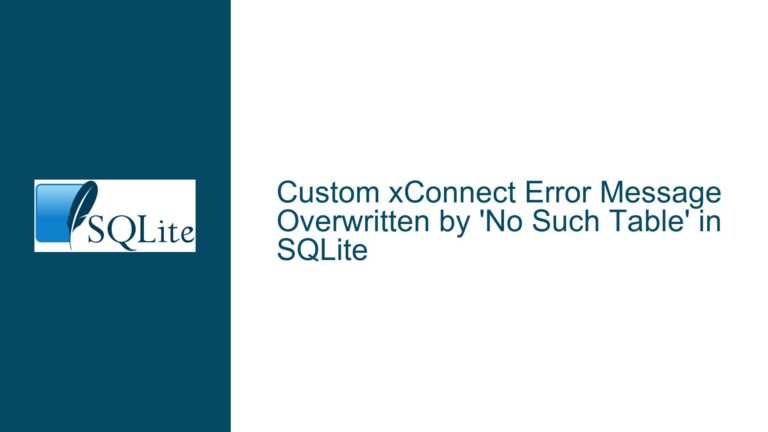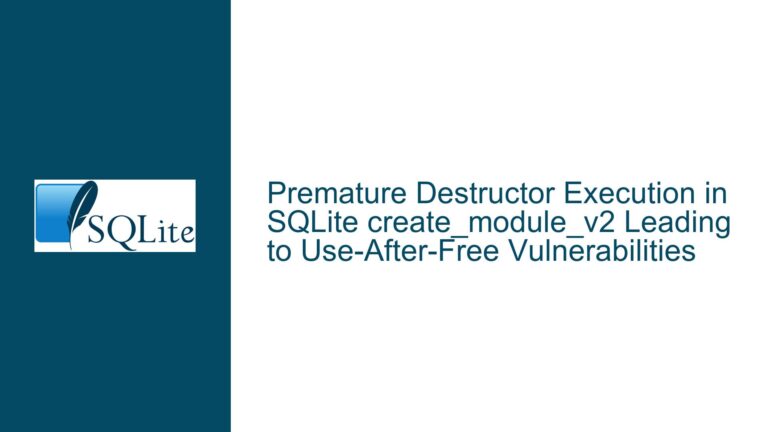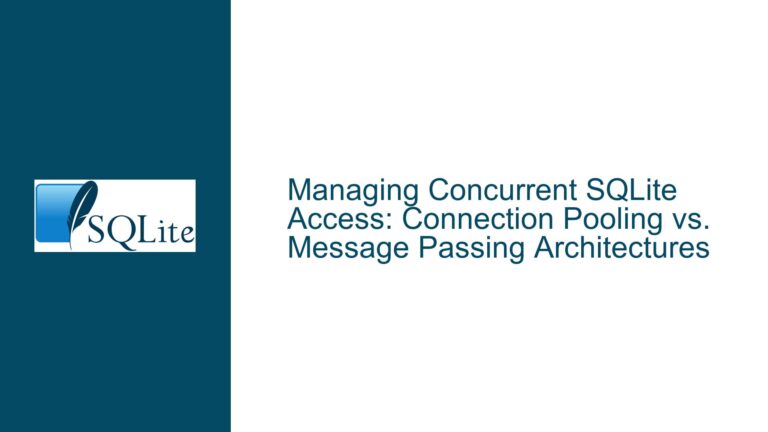Using SQLite In-Memory Databases with WAL Mode: Limitations and Workarounds
SQLite In-Memory Databases and WAL Mode Compatibility
SQLite in-memory databases are a powerful tool for applications requiring fast, temporary data storage without the overhead of disk I/O. These databases reside entirely in RAM, making them ideal for scenarios where performance is critical, and data persistence is not a requirement. However, one of the most common questions that arise when using SQLite in-memory databases is whether they support Write-Ahead Logging (WAL) mode, a feature designed to enhance concurrency and performance in disk-based databases.
WAL mode is a journaling mechanism that allows multiple readers and a single writer to operate on the database simultaneously without blocking each other. It achieves this by writing changes to a separate WAL file before applying them to the main database file. This approach significantly improves concurrency and can lead to better performance in multi-threaded or multi-process environments. However, the nature of in-memory databases introduces unique challenges when attempting to use WAL mode.
In-memory databases, by definition, do not have a persistent storage medium. All data resides in volatile memory, and once the database connection is closed or the application terminates, the data is lost. This characteristic directly impacts the feasibility of using WAL mode, as WAL relies on a persistent log file to track changes before they are committed to the main database. Without a persistent storage medium, the concept of a Write-Ahead Log becomes problematic, as there is no place to store the log file.
The SQLite documentation explicitly states that in-memory databases do not support WAL mode. Instead, they default to using a rollback journal, which is also stored in memory. This rollback journal allows for atomic commits and rollbacks but does not provide the same level of concurrency as WAL mode. The lack of WAL support in in-memory databases is a direct consequence of their transient nature and the absence of a persistent storage medium for the WAL file.
The Role of Shared-Cache Mode and URI Connections in Concurrency
While SQLite in-memory databases do not support WAL mode, there are alternative approaches to achieving some level of concurrency. One such approach is using shared-cache mode in combination with URI connections. Shared-cache mode allows multiple database connections to share a single cache, which can be beneficial in scenarios where multiple threads or processes need to access the same in-memory database.
When using shared-cache mode, each connection operates independently but shares the same underlying cache. This setup can reduce memory usage and improve performance in certain scenarios. However, it also introduces contention on the cache, as multiple connections may attempt to access or modify the same data simultaneously. This contention can lead to performance degradation, especially in high-concurrency environments.
URI connections provide a way to open multiple connections to the same in-memory database. By specifying a URI with the file::memory:?cache=shared parameter, you can create a shared in-memory database that multiple connections can access. This approach allows for some level of concurrency, as multiple readers can operate simultaneously. However, it does not provide the same level of isolation and concurrency as WAL mode, and write operations will still block other connections.
Shared-cache mode and URI connections are not without their drawbacks. The shared cache can become a bottleneck, especially in scenarios with high write contention. Additionally, shared-cache mode is generally not recommended for use in production environments due to its limitations and potential for performance issues. However, for certain use cases, such as read-heavy workloads or applications running on resource-constrained devices, these techniques can provide a viable alternative to WAL mode.
Implementing Custom VFS for Advanced In-Memory Database Concurrency
For developers requiring advanced concurrency features in SQLite in-memory databases, implementing a custom Virtual File System (VFS) is a potential solution. A custom VFS allows you to define how SQLite interacts with the underlying storage medium, providing the flexibility to emulate a RAM disk or other in-memory storage mechanisms.
By creating a custom VFS, you can potentially implement a form of shared memory that mimics the behavior of WAL mode. This approach would involve creating a shared memory segment that multiple connections can access, allowing for concurrent read and write operations. However, implementing a custom VFS is a complex task that requires a deep understanding of SQLite’s internals and the underlying operating system’s memory management.
One of the challenges of implementing a custom VFS for in-memory databases is handling shared memory (SHM) files, which are used by WAL mode to coordinate between multiple connections. In a traditional disk-based database, SHM files are stored on the filesystem, but in an in-memory database, these files would need to be emulated in memory. This emulation requires careful management of memory allocation and synchronization to ensure that multiple connections can access the shared memory without conflicts.
Another consideration when implementing a custom VFS is the handling of WAL files. Since in-memory databases do not have a persistent storage medium, the WAL file would also need to be stored in memory. This approach introduces additional complexity, as the WAL file must be managed in a way that ensures data consistency and durability, even though the database itself is transient.
While implementing a custom VFS can provide a high degree of flexibility and control, it is not a task to be undertaken lightly. The complexity and potential for subtle bugs make this approach suitable only for advanced users with specific requirements that cannot be met by other means. For most applications, the limitations of in-memory databases and the lack of WAL mode support are acceptable trade-offs given the performance benefits of in-memory storage.
Conclusion: Balancing Concurrency and Performance in SQLite In-Memory Databases
SQLite in-memory databases offer significant performance advantages for applications requiring fast, temporary data storage. However, the lack of support for WAL mode introduces challenges when attempting to achieve high levels of concurrency. While shared-cache mode and URI connections provide some level of concurrency, they are not without their limitations and potential performance issues.
For developers with advanced requirements, implementing a custom VFS can provide a way to emulate WAL mode in an in-memory database. However, this approach is complex and requires a deep understanding of SQLite’s internals and the underlying operating system’s memory management. For most applications, the trade-offs between concurrency and performance are acceptable, and the simplicity and speed of in-memory databases make them a valuable tool in the developer’s toolkit.
In summary, while SQLite in-memory databases do not support WAL mode, there are alternative approaches to achieving concurrency. Shared-cache mode and URI connections provide some level of concurrency, while custom VFS implementations offer advanced capabilities for those with specific requirements. Understanding these options and their trade-offs is essential for making informed decisions when designing and implementing applications that use SQLite in-memory databases.






